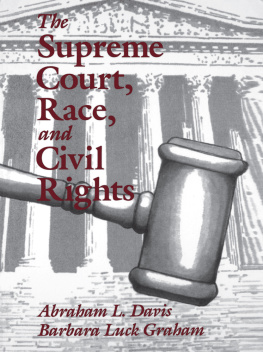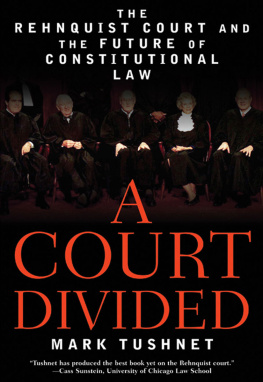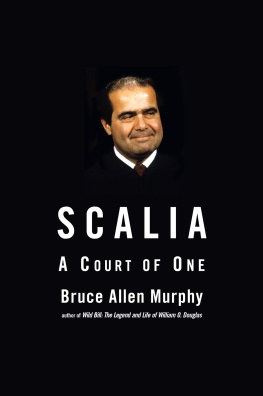Table of Contents
ALSO BY
JOHN A. JENKINS
The Litigators: Inside the Powerful World
of Americas High-Stakes Trial Lawyers
Ladies Man: The Life and Trials
of Marvin Mitchelson
To Daryl Alexander, Michael VerMeulen,
and Alex Ward:
You believed.
RESEARCHERS
WASHINGTON, DC
Chelsey D. Goff
Alyssa Hellman
Amanda Rogers
PALO ALTO, CALIFORNIA
Malia Wollan
INTRODUCTION
IT WAS FRIDAY EVENING, December 10, 1971, and President Nixon was calling.
Congratulations were in order. William Rehnquist had survived a messy confirmation battle and soon would take his chair as the newest justice on the Supreme Court. The good wishes were coming from all over, of course, but none was as important as this first and only talk that Rehnquist would ever have with the president. The White House operator already had Rehnquist on the line when Nixon came on. The president was ebullient.
Well, you must feel like Chief Justice Hughes, Nixon began. He had 26 voting against him, too.
Rehnquist was at a loss for a rejoinder, still getting his feet under him. Is that the exact number?
Of course it was. I just got it in front of me. So, like Hughes, you can go out and say, I had 26 against me.
Neither man was much for small talk. Rehnquist listened as the president went on, kidding about an endorsement of Rehnquists nomination by the liberal newspaper columnist Joseph Kraft. Treasury Secretary John Connally, a shrewd Texas politico, had shown Krafts column to Nixon, and I said Ive made a mistake!
Listen, Rehnquist broke in, I cant tell you how much I appreciate your giving me this opportunity.
Well, this is a great thing, to be such a young man, to go on the Court. Nixon exulted when he thought about the young reactionary who now was on the Court. Rehnquist was only forty-seven years old, ten years the junior of any other justice.
Youll make a great record, and, you know, the very fact that. Nixon halted, then started again. Ill give you one last bit of advice because youre going to be independent, naturally. And that is, dont let the fact that you were under heat change any of your views.
Ill remember that, Mr. President.
I told Warren Burger that, and he didnt get much heat, but I told him, Just dont come down herethe way I put it to himand let the Washington social set change you. So just be as mean and rough as they said you were. OK?
Thanks, Mr. President.
Good luck. Bye.
ONLY SEVENTEEN MEN HAVE PRESIDED over the Supreme Court, shaping our lives and our destiny as much as any president or leader of Congress. John Marshall gave voice to the judiciarys authority in Marbury v. Madison. Roger Taney set the nation on the path to civil war in Dred Scott. William Howard Taft modernized the judiciary. Charles Evans Hughes led a divided Court through the upheaval of the Great Depression. Earl Warren used the Bill of Rights to craft vital new protections for individual liberties and helped to steer the nation peacefully through the civil rights revolution.
William Rehnquists life story is profoundly significant yet largely unknown, which is how he wanted it. Rehnquists place on the Court was at once an accident of history and an inevitable result of itsomething that Rehnquist had secretly coveted since law school and yet could never have connived to obtain. His nomination in 1971 was one of the modern political eras most unlikely appointments: a spur-of-the-moment selection, of a candidate bereft of judicial credentials. He is the last of a breed.
Rehnquist was a brilliant loner who used the Court to advance his right-wing agenda. But to call Rehnquist simply a conservative would be to miss the essence of what defined him. Rehnquists judicial philosophy was nihilistic at its core, disrespectful of precedent and dismissive of social, economic, and political institutions that did not comport with his black-and-white view of the world. Rehnquist instinctively knew whose side he was on when it came to criminals and law abiders, minorities and the white majority, the poor and the rich, the powerless and the powerful. He set his plan accordingly. Infatuated with his own genius, he spoke his mind, cast his votes, and damned his critics.
Early on, Rehnquists iconoclasm made him a darling of the political right. He was perfectly cast as the brash, articulate outsider. But as chief justice, Rehnquist did notindeed, could notevolve. Dogma trumped leadership. Thus, despite his intellectual gifts, Rehnquist left no body of law or opinions that define his tenure as chief justice or even seem likely to endure. Instead, Rehnquist bestowed a different legacy, and the story of how it came to be is important in the political canon. Rehnquist made it respectable to be an expedient conservative on the Court.
The Supreme Court now is as deeply divided politically as the executive and legislative branches of our government, and for this Rehnquist must receive the credit or the blame. He provided the clear voice for instinctual decision making that pushed the Court markedly rightward. His successor as chief justice, John Roberts, is his natural heir.
The Rehnquist Court (19862005) thus was molded in his image, and the change endures. In thirty-three years on the Supreme Court (nineteen as chief justice), from 1972 until his death at age eighty in 2005, Rehnquist was at the center of the Courts dramatic political transformation. He was on a partisans mission, waging a quiet, constant battle to imbue the Court with a deep conservatism favoring government power over individual rights.
Disciples like Roberts carry on. Under Roberts, who clerked for Rehnquist, the Court remains unrecognizable as an agent of social balance even after its 54 decision upholding the Affordable Care Act. Gone are the majorities that rejuvenated the Bill of Rights, enfranchised black citizens, dismantled southern segregation, protected people from police abuse, removed religion from public schools, forced a president from office, and safeguarded a womans right to abortion.
The story of how and why Rehnquist rose to power is as compelling as it is improbable. Rehnquist left behind no memoir, and the fact that there has never been a serious biography of him is understandable: Rehnquist was an uncooperative subject, and during his lifetime he made an effort to ensure that journalists would have scant material to work with.
When, in December 1984, thenAssociate Justice Rehnquist sat for two hour-long interviews with me in his chambers, his answers revealed much about his personality and philosophy, but they were also reflective of a cagey lawyers literalism and shrewdness. Replies were confined to the specific question; information was seldom volunteered. Sometimes he feinted with a plea that he simply didnt understand the question. The justice was particularly reticent about matters he considered personalnames of the judges he played poker with, details about his family. Im not going to write your story for you, he said.
His participation was under duress, he asserted at the time. More than a decade later he hadnt changed his mind. He wrote to the editors at the








